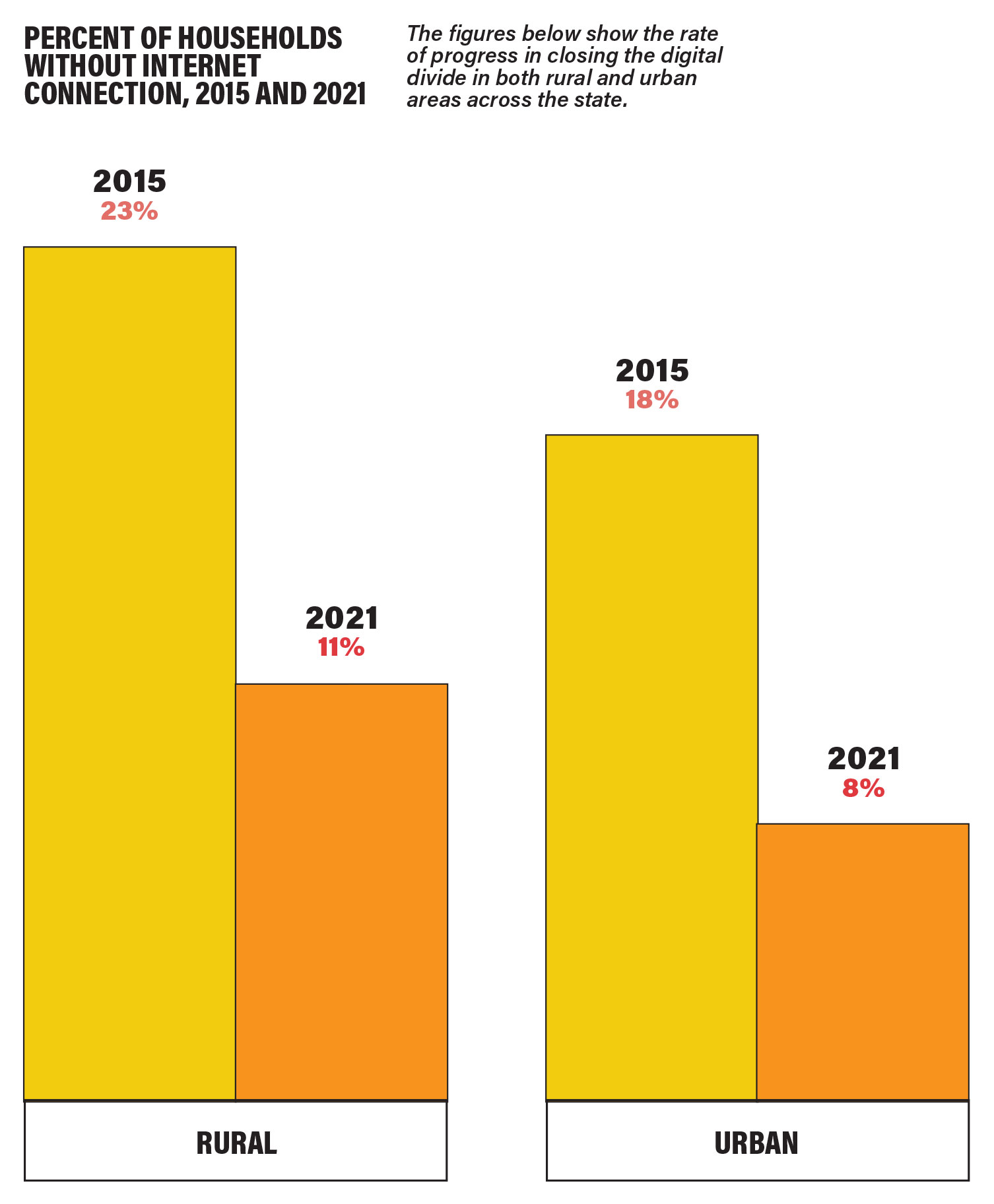Technology
Experts: Pennsylvania missed identifying thousands of unserved internet areas
The Broadband Development Authority could cause the state to lose out on millions in federal funding by failing to identify broadband needs.

The pressure’s on the Broadband Development Authority to get more Pennsylvanians online. BJDLZX/Getty Images
Along the New York state border in rural Potter County – the commonwealth’s fifth-least populated county – it can take upwards of an hour to drive to the nearest department store or shopping center. If residents need something that isn’t at the local Dollar General, they’re likely to turn to online marketplaces to deliver items rather than drive even farther to find them – a stark example of why the movement to classify internet access as a utility continues to gain strength.
Michele Moore, executive director of the Potter County Education Council, told City & State that as broadband access has increased in the region, it’s become an increasingly important resource for residents of all ages.
“(Older) generations have had to learn along the way, whether they did voluntarily or whether they were pulled along because of how things are now,” Moore told City & State. “But I think it’s because technology has become so ingrained in our daily lives.”
Moore works with the Area Agency on Aging and Tri-Co Connections, an internet service provider, in organizing the Seniors 2 Seniors program, which pairs senior citizens with high school seniors to help them learn computer and technology skills.
Seniors 2 Seniors, which is now operating in Tioga County and looking to expand into more communities, displays the importance of equitable and affordable internet connectivity in real-time.
“Before Tri-Co Connections came in and built out broadband internet, we were a digital access desert up here,” Moore said. “The companies that were here weren’t offering high-speed internet – or, if they were, it was ridiculously priced to the point where people couldn’t afford it.”
Potter County is far from the only part of the state struggling to get reliable high-speed internet – and the pressure to provide that access is only increasing on state officials.
Even though the commonwealth is set to receive more than $1 billion from two federal funding sources specifically intended for broadband expansion, it remains unclear just how that money will be spent to make real progress – and whether the Broadband Development Authority, the state entity created to deal with the issue, even knows the true extent of the state’s digital divide.
The commonwealth’s connectivity
Fast, easy internet access continues to be unattainable for too many Pennsylvanians – a disadvantage dramatically displayed during the pandemic-fueled online migration of everyday life.
“Everybody went to work, to school, church, the doctor and just kept in touch with friends and family from home,” Todd Eachus, president of the Broadband Cable Association of Pennsylvania, told City & State. “Those without broadband were left behind.”
According to the Federal Communications Commission, an unserved area is an area or address that lacks access to broadband speeds of 25 megabits per second for downloads and three megabits for uploads. Underserved areas meet those speed thresholds but still have speeds of less than 100 Mbps for downloads and 20 Mbps for uploads. Initial estimates from the latest National Broadband Map show that the commonwealth has nearly 300,000 unserved areas – accounting for roughly 6% of all registered service areas.
Sascha Meinrath, a telecommunications expert at Penn State University, expressed serious concerns with the lack of internet access in many regions around the state, as well as the Broadband Development Authority’s inconsistencies in helping collect accurate access data and assist counties.
“One of the big indicators of economic collapse is lack of broadband – this is an existential threat for a growing number of different constituencies and communities,” Meinrath said.
The Development Authority
The Pennsylvania Broadband Development Authority was established through Act 96 of 2021 to manage federal Infrastructure Investment and Jobs Act funding coming into the state. Its plan to expand broadband access across the commonwealth focuses on improving four key areas: broadband service infrastructure and availability; digital equity and affordability; device and technology access; and digital literacy and technical support.
Two significant federal funding streams are opening up to help states provide universal broadband connectivity and narrow the digital divide. The first, the Capital Projects Fund, which is run through the U.S. Treasury, is contributing $200 million to projects focused on work, education and public health in the state. The second, the Broadband Equity, Access, and Deployment (BEAD) program, has a $42.45 billion kitty to be distributed based on the number of households without access in each state.
State Sen. Kristin Phillips-Hill, a leading voice for broadband expansion and secretary of the Broadband Development Authority, said that accurate maps are critical to ensure that the state both identifies unserved areas and is allocated its fair share of the federal funds.

“Our deployment will only be as good as our mapping,” she told City & State. “If that map isn’t accurate, we could potentially be putting funds into providing broadband in places that already have it and skipping areas that don’t – and that would be a failure.”
The Broadband Development Authority entered into a contract with the Penn State Extension late last year to develop and update state broadband maps and assist with the FCC challenge process. Several counties also conducted their own surveys and issued challenges to the FCC, while others hired consultants to help them advance their challenges.
Andy Waple, deputy executive director of Southwestern Pennsylvania Commission’s programs division and a leader in the region’s strategic planning, said he was given just two months to review maps and identify unserved areas. Counties were in a “mad dash” to challenge the FCC maps before the deadline in January.
“We have to make sure that we’re engaging a lot of different folks in the process and meeting with community groups and nonprofits and really getting local,” Waple told City & State. “It gets back to the fact that it’s not a one-size-fits-all” approach.
County complications
The number of households lacking access in the commonwealth will ultimately determine how much the state receives from the BEAD program, but some experts believe that the Broadband Development Authority missed out on identifying hundreds, if not thousands, of homes – and thus on millions in federal funding.
“We created a political beast as opposed to what was originally conceptualized, which was a broadband authority led by area experts,” Meinrath said. “That is going to bite us in the ass.”
The BEAD program’s billions will be divvied up equitably to ensure states with more accessibility needs will receive more funding. Estimates show that every unserved house added to a state’s map could increase the funding it receives anywhere from $3,000 to $5,000, according to Penn State.
Meinrath said Penn State found more than 600,000 potential locations that need to be checked to see if they lack access and should’ve been included in the map. He added that even with a conservative estimate of about 100,000 additional unserved locations, the state would still be missing out on upwards of another half-billion dollars.

The Broadband Development Authority announced the approval of grant guidelines for the $200 million coming from the Capital Projects Fund in April. Distributed through the Pennsylvania Broadband Infrastructure Program, the $200 million in American Rescue Plan funding is set to expand high-speed internet access to more than 44,000 homes and businesses throughout the commonwealth. The application window for the grants opened May 10 and closes July 10. The authority expects to award grants by the end of the year.
A stipulation with Capital Project Fund grant applications, however, is that applicants must commit to investing a minimum amount of capital to finance a proposed project. The grant guidelines released in April put that number at a 25% match, meaning local governments would be on the hook for paying for a portion of any federal or state funding they receive.
The authority is required to have some form of grant matching but Meinrath argued that 25% will only put the rural areas the funding is meant to serve further in a hole.
“The eligibility criteria are made more difficult for counties. They are having to pay tens of millions of dollars for a minimum 25% match to a $200 million program,” Meinrath said. “The federal grant program has no required match. The state broadband authority is requiring a match. That is just bad politics.”
In a statement, Broadband Development Authority Executive Director Brandon Carson said the Capitol Projects Fund broadband infrastructure draft guidelines were crafted "to ensure all Pennsylvanians have access to reliable highspeed internet service, particularly those who are unserved and underserved. The finer points of finalizing the guidelines focused on ensuring an adequate workforce to build out awarded projects," Carson said.
The requirements for local governments to receive the first round of more flexible federal funding, combined with the potential of not identifying thousands of unserved areas in the second round of funding could mean many homes and businesses could be left paying more than they anticipated or fall through the cracks altogether.
The authority estimated the state should receive between $1.2 and $1.4 billion based on its broadband map challenges, but other assessments – including Meinrath’s – say that number should be closer to $1.6 billion.
“A lot of other states have devoted money to broadband mapping, so they are increasing their number of unserved homes – and we are not,” he said, pointing out that other states established boards specifically for the purpose of such mapping.
Phillips-Hill said the Broadband Authority and Harrisburg lawmakers did everything in their power to get the message out to counties regarding map challenges given the federal government’s limited timeframe for submissions.
“We held meetings and we put out press releases,” she told City & State. “I can’t tell you how many times I pushed it out to my constituents and we pushed it out to all my colleagues here in the Senate.”
Lines crossed
Some counties identified thousands of unserved areas that did not appear on the FCC’s address maps. In Westmoreland County, officials identified 14,527 sites, or 8% of the 175,251 address points in the county. In Washington County, the challenge identified 617 sites, including 19 places that FCC maps indicated were served by broadband but the county determined were not.
Local governments have also taken matters into their own hands to begin broadband expansion before federal funds arrive. Using already-distributed ARPA dollars and obtaining discretionary funding through other sources, counties and municipalities across the commonwealth conducted their own feasibility studies or began working on their own development plans.

Washington, Greene and Indiana counties are already leading broadband expansion efforts at the local levels, but ensuring these efforts aren’t duplicated at the state level – and that no locality is left behind – adds another layer of complexity to the process.
A prime example of the lack of government coordination, Meinrath claimed, is the state’s planned use of Capital Project Fund dollars for the purpose of broadband development in unserved rural areas. He said that the flexibility of the Capital Project Fund dollars would allow them to fill in gaps where other grants and programs are restricted, but in Pennsylvania, that hasn’t been the case. The General Assembly appropriated the $200 million allocation to the Broadband Development Authority to establish grant programs and identity eligible projects.
“They’re looking to deploy funds that are more agile to areas that are already going to be covered by BEAD funds,” Meinrath argued. “It’s myopic, it’s foolhardy and it guarantees that we don’t achieve universal service.”
Phillips-Hill pushed back, stating the authority’s allocations are following state and federal rules.
While Capital Project Fund grants can be more flexible, according to the U.S. Treasury, the grant funding must be limited to broadband infrastructure projects, digital connectivity technology projects and multi-purpose community facility projects.
“These were dollars that came through as a result of the pandemic and these dollars are targeting something slightly different than what federal BEAD dollars will cover,” Phillips-Hill said. “The money is going to go to a whole host of other things – and much of that is being dictated to us by the federal government.”
What’s Next
In order to receive and distribute BEAD funding, the commonwealth is required to complete a five-year action plan by Aug. 12 and a State Digital Equity Plan by Oct. 31.
President Joe Biden committed to a June 30 deadline to allocate BEAD funds. If the state’s five-year plan is in place by the fall, as expected, it can anticipate opening grant programs for BEAD in early 2024.
Meinrath said the authority isn’t prepared for what’s to come. Not only do questions remain regarding the state’s ability to calculate the true extent of its digital divide, but new issues may arise as entities attempt to apply for grants and fill in gaps where they can’t afford to keep up with the required match and ongoing maintenance.
“We’re seeing failure rates in a large proportion of rural areas,” Meinrath said, estimating that more than 20% of those connectivity efforts will fall short. “This is really going to come to a head in the next 12 to 18 months. We will, in essence, be spending over a billion dollars – and what we get for it will be not great.”
Editor's note: Previous versions of this story included a map that contained inaccuracies. We have removed that graphic accordingly.
